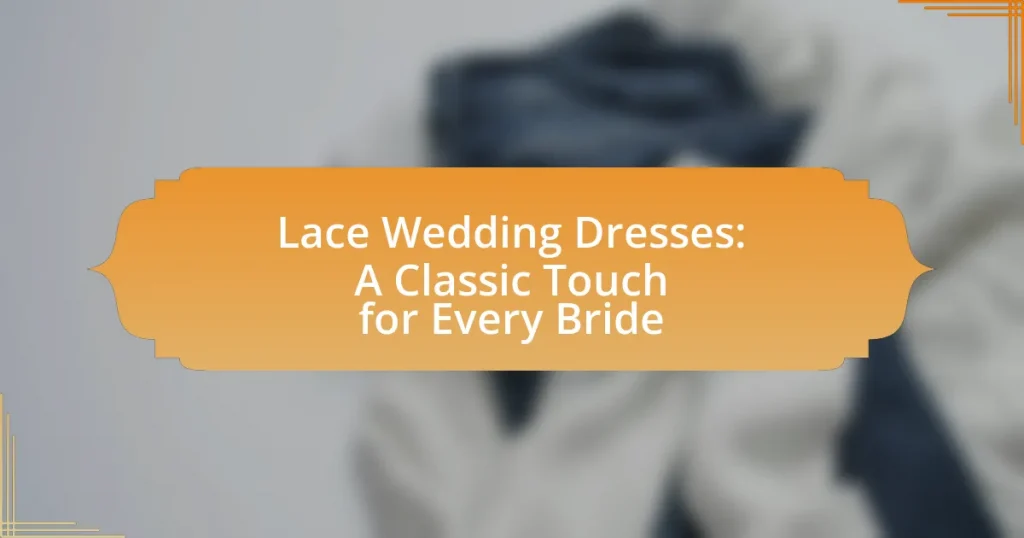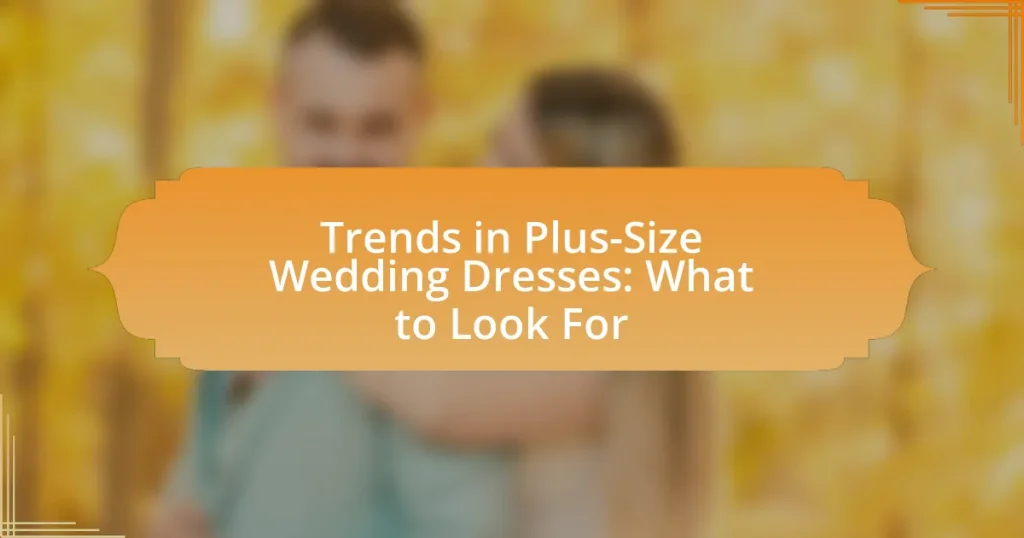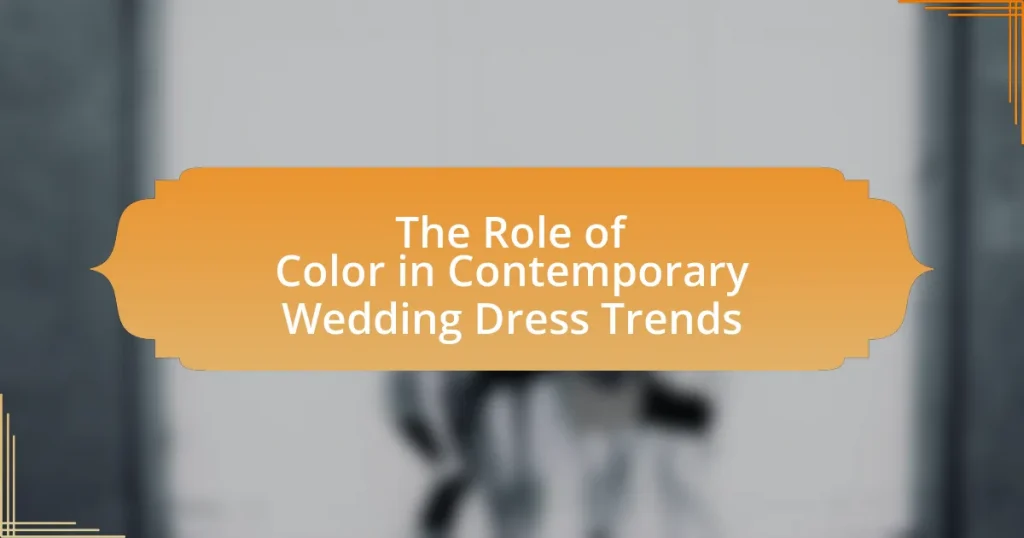Lace wedding dresses are bridal gowns that prominently feature lace fabric, known for its intricate patterns and textures that evoke elegance and romance. The article explores the historical significance of lace in wedding attire, tracing its popularity from the 16th century to modern times, and discusses various styles, types of lace, and how cultural traditions influence their design. Key features, including different silhouettes and necklines, are examined, along with practical considerations for brides such as body types, seasonal choices, and budget factors. Additionally, the article highlights current trends in lace wedding dresses, including innovative designs and popular colors, providing brides with essential insights for selecting the perfect gown.
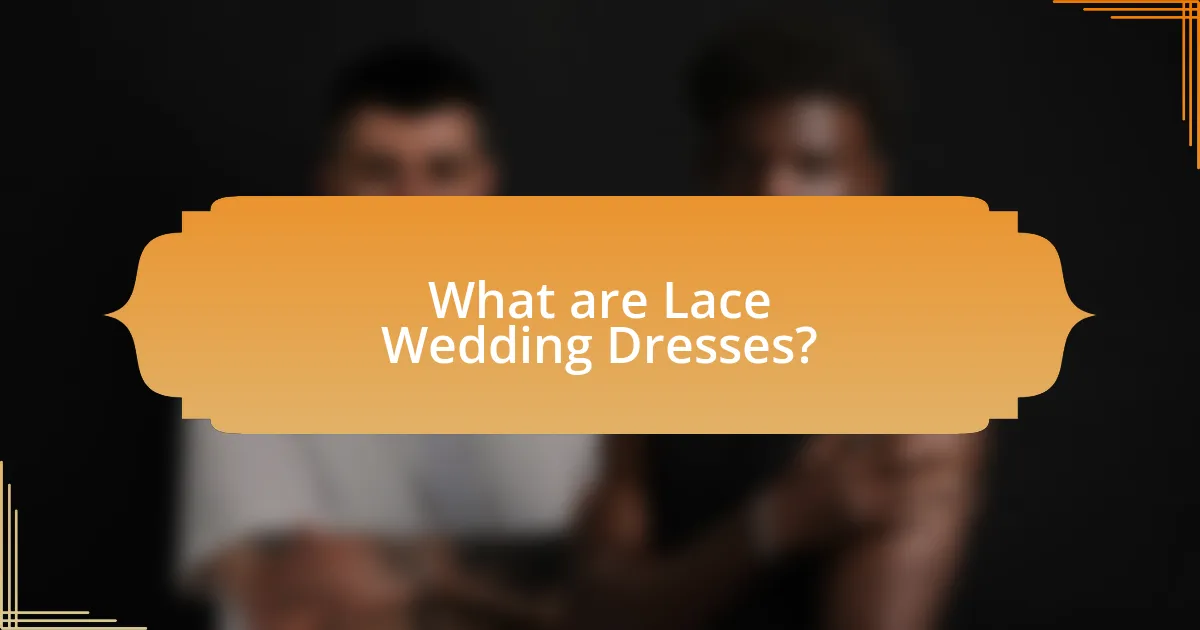
What are Lace Wedding Dresses?
Lace wedding dresses are bridal gowns that incorporate lace fabric as a primary design element. This type of dress is characterized by intricate patterns and textures created by the lace, which can range from delicate floral motifs to bold geometric designs. Historically, lace has been used in wedding attire since the 16th century, symbolizing elegance and sophistication. The use of lace in wedding dresses enhances the overall aesthetic, providing a romantic and timeless appeal that many brides seek for their special day.
How did Lace Wedding Dresses become a popular choice for brides?
Lace wedding dresses became a popular choice for brides due to their timeless elegance and intricate designs that symbolize romance and femininity. Historically, lace has been associated with luxury and sophistication, dating back to the 16th century when it was used by nobility. The resurgence of lace in bridal fashion during the 19th century, particularly with Queen Victoria’s lace-trimmed wedding gown, solidified its status as a bridal favorite. Additionally, modern designers continue to innovate with lace, offering diverse styles that appeal to contemporary brides, further enhancing its popularity.
What historical influences shaped the design of Lace Wedding Dresses?
The design of lace wedding dresses has been shaped by various historical influences, primarily from the Renaissance and Victorian eras. During the Renaissance, lace became a symbol of wealth and status, as it was intricately hand-made and often used in the garments of nobility. This period saw the introduction of delicate lace trims and embellishments in bridal attire, reflecting the opulence of the time.
In the Victorian era, lace gained further prominence as Queen Victoria popularized white wedding dresses, which often featured lace details. The use of lace in wedding dresses became a tradition, symbolizing purity and elegance. The intricate patterns and craftsmanship of lace were celebrated, leading to its enduring presence in bridal fashion.
These historical influences have established lace wedding dresses as a timeless choice, combining artistry and tradition in modern bridal wear.
How do cultural traditions impact the use of lace in wedding dresses?
Cultural traditions significantly influence the use of lace in wedding dresses by dictating styles, symbolism, and materials. For instance, in Western cultures, lace is often associated with elegance and purity, leading to its widespread use in bridal gowns since the Victorian era, where intricate lace patterns symbolized wealth and social status. In contrast, some Asian cultures may incorporate lace differently, using it to blend traditional motifs with modern designs, reflecting a fusion of heritage and contemporary fashion. Historical evidence shows that lace was a luxury fabric in Europe, making it a popular choice for brides seeking to convey sophistication and tradition.
What are the key features of Lace Wedding Dresses?
Lace wedding dresses are characterized by their intricate designs, delicate textures, and timeless elegance. The key features include various lace types such as Chantilly, Alençon, and Guipure, which contribute to the dress’s overall aesthetic. Additionally, lace wedding dresses often feature detailed embellishments like beading or embroidery, enhancing their visual appeal. The fabric’s lightweight nature allows for comfortable wear, making it suitable for various wedding settings. Lace also provides a romantic and vintage feel, appealing to brides seeking a classic look. These features collectively make lace wedding dresses a popular choice among brides.
What types of lace are commonly used in wedding dresses?
Common types of lace used in wedding dresses include Chantilly lace, Alençon lace, and Guipure lace. Chantilly lace is known for its delicate floral patterns and fine netting, making it a popular choice for romantic designs. Alençon lace features a heavier, embroidered design with a distinctive floral motif, often used for a more structured look. Guipure lace, characterized by its bold patterns and open weave, adds texture and dimension to wedding gowns. These laces are favored for their aesthetic appeal and ability to enhance the elegance of bridal attire.
How does the choice of lace affect the overall style of the dress?
The choice of lace significantly influences the overall style of the dress by determining its texture, elegance, and visual appeal. Different types of lace, such as Chantilly, Alençon, or Guipure, each bring unique characteristics that can enhance or alter the dress’s aesthetic. For instance, Chantilly lace is known for its delicate floral patterns and sheer quality, which can create a romantic and ethereal look, while Alençon lace, with its heavier embroidery, adds a more structured and opulent feel. The lace’s color and placement also play crucial roles; white lace on a traditional gown evokes classic bridal elegance, whereas colored lace can introduce modernity and individuality. Thus, the choice of lace not only affects the dress’s style but also conveys the bride’s personal taste and the overall theme of the wedding.
What styles of Lace Wedding Dresses are available?
Lace wedding dresses are available in several styles, including A-line, ball gown, mermaid, sheath, and tea-length. Each style offers a unique silhouette and aesthetic, catering to different preferences and body types. For instance, A-line dresses feature a fitted bodice that flares out gently from the waist, providing a flattering look for many brides. Ball gown styles are characterized by a full skirt and fitted bodice, creating a classic, fairy-tale appearance. Mermaid dresses are fitted through the bodice and hips, flaring out at the knees, which accentuates curves. Sheath dresses offer a more streamlined silhouette that follows the body’s natural shape, while tea-length dresses provide a vintage vibe with a hem that falls between the knee and ankle. These styles reflect the versatility and timeless appeal of lace in bridal fashion.
What are the differences between A-line, ball gown, and mermaid styles in lace dresses?
A-line, ball gown, and mermaid styles in lace dresses differ primarily in their silhouette and fit. The A-line style features a fitted bodice that gradually flares out from the waist, creating a shape resembling the letter “A,” which is flattering for various body types. The ball gown style has a fitted bodice and a voluminous skirt that extends from the waist, often requiring a petticoat for added fullness, making it ideal for formal occasions. In contrast, the mermaid style is fitted through the bodice and hips, then flares out at or below the knee, accentuating the curves and providing a more dramatic look. These distinctions in silhouette cater to different aesthetic preferences and body shapes, allowing brides to choose a style that best suits their vision for their wedding day.
How do different necklines enhance the beauty of lace wedding dresses?
Different necklines enhance the beauty of lace wedding dresses by framing the face and accentuating the bride’s features. For instance, a sweetheart neckline highlights the collarbone and adds a romantic touch, while a V-neckline elongates the neck and creates a slimming effect. Additionally, off-the-shoulder necklines showcase the shoulders and arms, adding an elegant and timeless appeal. Each neckline type interacts uniquely with lace patterns, enhancing the intricate details and textures of the fabric, which is a hallmark of lace wedding dresses. This interplay between neckline design and lace enhances the overall aesthetic, making the dress more visually striking and personalized for the bride.
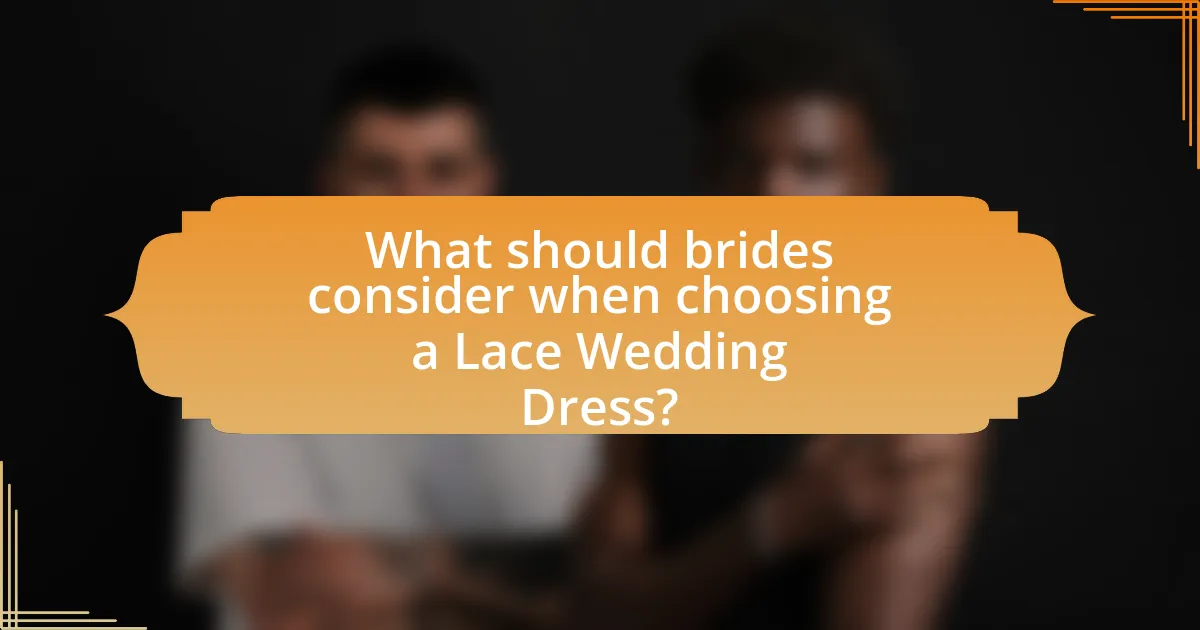
What should brides consider when choosing a Lace Wedding Dress?
Brides should consider the fabric quality, lace pattern, and fit when choosing a lace wedding dress. High-quality lace enhances the overall look and durability of the dress, while intricate patterns can add elegance and uniqueness. Additionally, the fit is crucial for comfort and confidence on the wedding day, as a well-fitted dress complements the bride’s figure and allows for ease of movement. According to bridal fashion experts, the right combination of these elements can significantly impact the bride’s overall experience and satisfaction with her choice.
How do body types influence the choice of Lace Wedding Dresses?
Body types significantly influence the choice of lace wedding dresses by determining the styles and silhouettes that best flatter each figure. For instance, hourglass figures often benefit from fitted lace gowns that accentuate curves, while A-line dresses with lace overlays are ideal for pear-shaped bodies, as they provide balance and elegance. Additionally, brides with athletic builds may prefer lace dresses with intricate detailing or ruffles to add softness and femininity. Research indicates that understanding body types can enhance the overall bridal experience, as selecting a dress that complements one’s shape can boost confidence and comfort on the wedding day.
What styles of lace dresses are most flattering for different body shapes?
A-line lace dresses are most flattering for various body shapes, as they create a balanced silhouette. For pear-shaped bodies, A-line styles accentuate the waist while skimming over the hips. Hourglass figures benefit from fitted lace dresses that highlight curves, while straight body shapes can opt for lace sheath dresses that add dimension. Additionally, empire waist lace dresses are ideal for apple-shaped bodies, as they draw attention away from the midsection. These styles are supported by fashion experts who emphasize the importance of silhouette in enhancing body shape.
How can brides accentuate their features with lace designs?
Brides can accentuate their features with lace designs by choosing styles that highlight their body shape and facial features. For instance, intricate lace patterns can draw attention to the neckline, enhancing the bride’s collarbone and shoulders, while strategically placed lace can create an hourglass silhouette, emphasizing curves. Additionally, lace sleeves can elongate the arms, and lace overlays can add texture and depth, making the overall look more visually appealing. Studies in fashion design indicate that lace’s delicate nature softens the overall appearance, which can enhance femininity and elegance, making it a popular choice for brides seeking to highlight their best features.
What practical factors should brides keep in mind?
Brides should keep in mind the fit, comfort, and maintenance of lace wedding dresses. The fit is crucial as it affects how the dress looks and feels throughout the day; a well-fitted dress enhances confidence and mobility. Comfort is equally important, as lace can be delicate and may cause irritation if not lined properly. Additionally, maintenance is a practical factor; lace requires careful cleaning and storage to preserve its quality, which can involve specific cleaning methods to avoid damage. These considerations ensure that brides can enjoy their special day without unnecessary distractions or concerns.
How does the season affect the choice of lace wedding dress?
The season significantly influences the choice of lace wedding dress by dictating the fabric weight, style, and design elements suitable for different weather conditions. For instance, spring and summer weddings often favor lighter lace materials and sleeveless or short-sleeved designs to accommodate warmer temperatures, while fall and winter weddings may lean towards heavier lace fabrics with long sleeves and additional layers for warmth. Additionally, seasonal color palettes can affect lace choices, with pastel shades being popular in spring and rich, deep hues favored in autumn.
What budget considerations should brides have for lace wedding dresses?
Brides should consider the cost of lace wedding dresses, which can range from $500 to over $5,000 depending on the designer, quality of lace, and intricacy of the design. The price is influenced by factors such as the type of lace used, with options like Chantilly or Alençon being more expensive due to their craftsmanship. Additionally, alterations can add another $200 to $600 to the overall budget, as lace dresses often require precise fitting. Understanding these variables helps brides allocate their budget effectively while ensuring they choose a dress that meets their aesthetic and financial expectations.
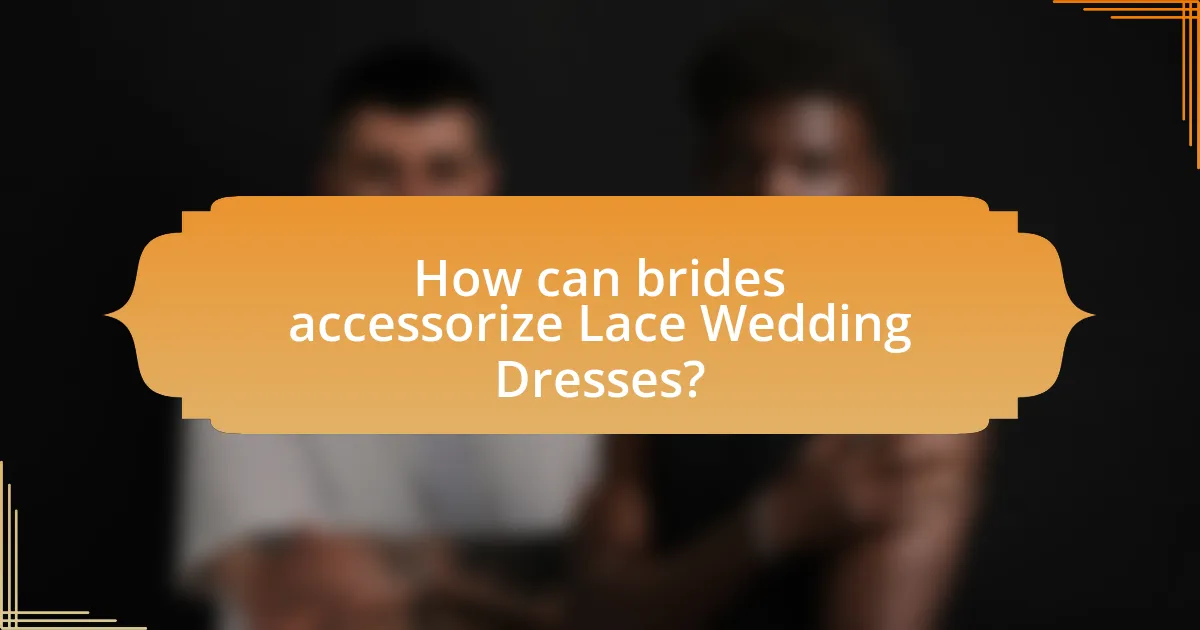
How can brides accessorize Lace Wedding Dresses?
Brides can accessorize lace wedding dresses by incorporating delicate jewelry, veils, and complementary footwear. Delicate jewelry, such as pearl earrings or a simple pendant necklace, enhances the intricate details of lace without overwhelming it. A veil, particularly one with lace trim, can create a cohesive look that ties in with the dress’s fabric. Complementary footwear, like elegant heels or embellished flats, can add a touch of personal style while maintaining the overall aesthetic. These accessories not only enhance the beauty of lace wedding dresses but also reflect the bride’s individual taste.
What types of accessories complement Lace Wedding Dresses?
Lace wedding dresses are complemented by accessories such as veils, tiaras, and delicate jewelry. Veils, particularly those with lace trim, enhance the romantic aesthetic of lace dresses. Tiaras or hairpins adorned with pearls or crystals add elegance without overwhelming the intricate lace details. Additionally, simple pearl or diamond earrings and bracelets provide a classic touch that harmonizes with the dress’s texture. These accessories not only enhance the overall look but also maintain the timeless appeal associated with lace wedding dresses.
How do veils and headpieces enhance the look of lace dresses?
Veils and headpieces enhance the look of lace dresses by adding layers of elegance and sophistication. The intricate designs of lace are complemented by the delicate textures of veils and headpieces, creating a harmonious visual balance. For instance, a lace dress paired with a flowing veil can soften the overall appearance, allowing the lace details to stand out while framing the face beautifully. Additionally, headpieces such as tiaras or floral crowns can draw attention to the bride’s hairstyle and facial features, further elevating the overall aesthetic. This combination not only highlights the craftsmanship of the lace but also contributes to a cohesive bridal look that is both timeless and romantic.
What jewelry styles work best with lace wedding dresses?
Delicate and vintage-inspired jewelry styles work best with lace wedding dresses. These styles complement the intricate details of lace, enhancing the overall romantic aesthetic. For instance, pearl earrings and necklaces add a classic touch, while filigree or floral designs in silver or gold can echo the lace patterns. Additionally, simple bracelets or hairpieces featuring lace motifs can create a cohesive look. The combination of these jewelry styles with lace wedding dresses emphasizes elegance and sophistication, making them ideal choices for brides.
What are some tips for maintaining Lace Wedding Dresses?
To maintain lace wedding dresses, it is essential to handle them with care, store them properly, and clean them appropriately. First, always store lace wedding dresses in a cool, dry place, ideally in a breathable garment bag to prevent yellowing and damage. Second, avoid hanging the dress on a hanger for extended periods, as this can stretch the lace; instead, lay it flat if possible. Third, when cleaning, opt for professional dry cleaning specifically for delicate fabrics, as home washing can lead to damage. Additionally, keep the dress away from direct sunlight to prevent fading and discoloration. These practices help preserve the integrity and beauty of lace wedding dresses over time.
How should brides care for their lace wedding dresses before and after the wedding?
Brides should store their lace wedding dresses in a cool, dry place before the wedding and have them professionally cleaned and preserved immediately after the event. Proper storage involves using a breathable garment bag to prevent moisture buildup, which can lead to mold or mildew. After the wedding, professional cleaning is essential to remove any stains or dirt, as untreated stains can become permanent over time. Preservation should include acid-free tissue paper and a suitable box to maintain the dress’s shape and prevent yellowing. These methods are supported by textile care experts who emphasize the importance of immediate and proper care to ensure the longevity of delicate fabrics like lace.
What are common issues brides face with lace and how can they be resolved?
Brides commonly face issues with lace such as fraying edges, discoloration, and difficulty in cleaning. To resolve fraying edges, brides can use a clear fabric sealant to prevent further damage. Discoloration can be addressed by storing lace garments in a cool, dark place and using gentle, pH-neutral detergents for cleaning. For cleaning difficulties, professional dry cleaning services that specialize in delicate fabrics can ensure the lace is treated properly without damage. These solutions are effective in maintaining the integrity and appearance of lace wedding dresses.
What are the latest trends in Lace Wedding Dresses?
The latest trends in lace wedding dresses include the use of intricate lace patterns, off-the-shoulder designs, and a blend of modern silhouettes with vintage elements. Designers are increasingly incorporating bold lace appliqués and layering techniques to create depth and texture, while also favoring sustainable materials. According to a 2023 bridal fashion report, 45% of brides are opting for dresses that feature unique lace detailing, reflecting a desire for personalization and individuality in their wedding attire.
How are modern designs incorporating lace in innovative ways?
Modern designs are incorporating lace in innovative ways by integrating it into unexpected elements such as sleeves, bodices, and even as overlays on non-traditional fabrics like tulle and satin. This approach allows designers to create unique textures and visual contrasts, enhancing the overall aesthetic of wedding dresses. For instance, the use of laser-cut lace patterns has gained popularity, enabling intricate designs that were previously difficult to achieve, thus providing a contemporary twist on classic lace. Additionally, designers are experimenting with color, using dyed lace to add depth and personalization to bridal wear, which reflects current trends in customization and individuality in wedding attire.
What colors and patterns are trending in lace wedding dresses today?
Trending colors in lace wedding dresses today include soft pastels like blush pink, lavender, and mint green, as well as classic shades such as ivory and champagne. Patterns that are popular feature floral motifs, intricate lace overlays, and geometric designs. These trends reflect a blend of traditional elegance and modern aesthetics, appealing to contemporary brides seeking unique styles. The popularity of these colors and patterns is supported by recent bridal fashion shows and industry reports, which highlight the shift towards softer hues and detailed lacework in wedding attire.
What are the best practices for selecting the perfect Lace Wedding Dress?
The best practices for selecting the perfect lace wedding dress include understanding your body shape, choosing the right lace type, considering the wedding theme, and ensuring comfort. Understanding your body shape helps in selecting a silhouette that flatters your figure, such as A-line or mermaid styles. Different lace types, like Chantilly or Alençon, offer varying textures and patterns, impacting the overall look. Aligning the dress with the wedding theme, whether vintage or modern, ensures cohesion in your bridal aesthetic. Lastly, prioritizing comfort is essential, as you will wear the dress for an extended period; ensure it allows for movement and fits well. These practices are supported by bridal experts who emphasize the importance of these factors in achieving a stunning and suitable wedding look.
